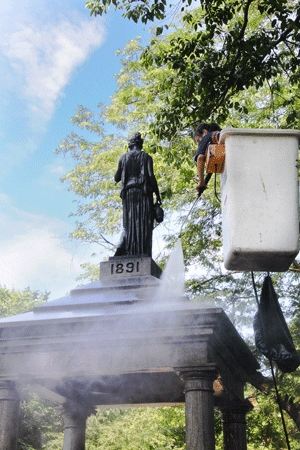 [/media-credit]
[/media-credit]
Conservators Christine Djuric and John Sanders, with a few graduate student interns, spent Friday morning June 8 taking care of the Temperance Fountain and the Slocum Memorial Fountain in the middle of the park and the statue of Samuel Sullivan Cox in the southeast corner.
“We’re using a pressure wash with a mild detergent on the stone and then a cold wax on the bronze stature at the top of the Temperance monument,” said Djuric, a conservator with the program for the past five years.
The granite canopy supported by four columns with Faith, Hope, Charity and Temperance engraved on four sides under a pyramidal pediment, with a bronze figure of Hebe, the water carrier, at the top, was erected in 1888. It was the gift of Henry D. Cogswell, a dentist who made $2 million in San Francisco during the Gold Rush years. Cogswell devoted himself and his fortune to the anti-alcohol movement and sponsored 50 Temperance Monuments across the country between 1877 and 1890.
The Slocum Memorial, dedicated to the 1,209 victims of a fire on the excursion steamer General Slocum in the East River on June 15, 1904, was erected two years after the disaster. The ship was taking the German-immigrant congregation of the St. Marks Evangelical Lutheran Church, mostly women and children, to an annual picnic when it caught fire and ran aground on North Brother Island in the East River. The 9-foot-tall slab of pink Tennessee marble with a bas-relief of two children was the gift of the Sympathy Society of German Ladies and designed by Bruno Louis Zimm.
Before Sept. 11, 2001, the Slocum fire had the highest death toll of any disaster in the city.
Sanders explained that the pink marble, really limestone, was used because it was soft enough to be carved, but
thus was unfortunately more susceptible than granite to weathering. Because of the monument’s historic value, the relief of two children in profile will not
be re-incised.
The bronze statue of Samuel Sullivan Cox was endowed by mail carriers from 188 cities who raised $10,000 for the monument that was unveiled in 1891. Cox was a congressman from Ohio from 1857 to 1865 and served again as a New York congressman from 1869 to 1889 after he moved to the city. He sponsored legislation that led to paid benefits and a 40-hour week for postal workers. Cox also promoted the U.S. Life Saving Service, which rescued boats imperiled by bad weather. The Coast Guard took over the service in 1915.
“The Monuments Conservation Program started in 1997 with private funding and includes a summer program of training for graduate students to get hands-on experience,” said Jonathan Kuhn, director of Art and Antiquities for the Parks Department.
At Tompkins Square last week, Chad Shore, a graduate student from Tennessee at Columbia’s School of Architecture and Historic Preservation, was getting hands-on experience along with Sean Belair, a New Yorker in the graduate preservation program at Lincoln University in England.
This week, the monuments crew began working on the Washington Square Arch, the Garibaldi statue and the monument to Alexander Lyman Holley in Washington Square Park.
Next week, in time for the Gay Pride celebration, the crew will turn its attention to George Segal’s 1992 “Gay Liberation” statues in Christopher Park across from the Stonewall Inn, as well as the statue of General Philip Sheridan, installed in Christopher Park in 1936.
At the end of June, the crew will work on the Independence flagstaff in Union Square Park. The monument, dedicated by the Tammany Society on July 4, 1930, for the 150th anniversary of the signing of the Declaration of Independence, includes a pedestal with bronze bas-reliefs and the full text of the Declaration of Independence. The monument was last renovated in 1987.

















